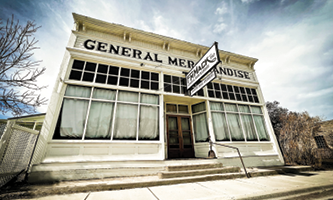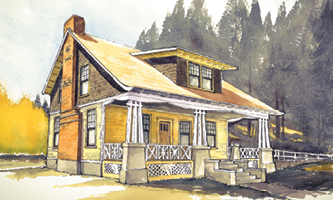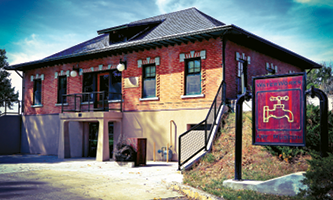Montana SHPO Grant Program
FOR BRICK-AND-MORTAR PRESERVATION PROJECTS
Deadline: February 10, 2025
Award range: $20,000-$100,000
Helping to preserve significant cultural resources and to foster economic development in Montana communities.
The Montana Historical Society's State Historic Preservation Office grants funds made available from the state accommodations tax to private, non-profit, and public owners of historic properties. Grants support physical repairs and improvements to properties listed in or eligible for listing in the National Register of Historic Places. All work must meet the Secretary of the Interior’s Standards for the Rehabilitation of Historic Properties.
Click on the images below to learn about past grant-funded projects.
About the SHPO Grant Program
Review the information below to determine if the grant program is right for you and your project. Then, view a recording of the WEBINAR held on Nov. 21, 2024, and download the current application GUIDELINES, FORM and INSTRUCTIONS.
The Montana State Historic Preservation Office (SHPO) Grant pays for the preservation of Montana’s historically significant buildings and structures. The program’s goal is to preserve significant cultural resources and foster economic development in Montana.
To qualify for the grant, applicants must demonstrate their property’s historical significance, its preservation needs, and how a completed project would contribute to its community.
Properties benefiting from SHPO Grants must be listed in the National Register of Historic Places. Owners of properties not already listed will consent to listing their SHPO Grant-supported property. Grantees will agree to a five- to ten-year preservation agreement based on the grant award amount.
Funding Available Per Award:
The estimated range of funding per award is $20,000-$100,000.
Cost Share:
Cost share is not required, however, applications demonstrating a SHPO-to-applicant cost share of at least 60:40 will score higher than those committing less cost share.
Number of Agreements Awarded:
SHPO anticipates awarding three to five grants.
SHPO guidance to applicants:
Visit https://mhs.mt.gov/shpo/grants to register for a November 21 orientation webinar to learn about the grant program and ask questions. Send your questions via email to shpogrant@mt.gov until the grant due date.
Montana Environmental Policy Act (MEPA) Review:
Projects selected for funding must demonstrate completion of the MEPA process prior to contracting for receipt of funds. SHPO will supply necessary forms.
Preservation Agreement:
Prior to signing a grant contract, grantees will enter into a preservation agreement with the State of Montana (SHPO) beginning with SHPO’s release of funds. Properties will be subject to a five-year easement for grant awards of $50,000 or less. Ten-year easements will apply to properties accepting a $50,001 to $100,000 grant. Preservation agreements require property owners to consult with SHPO on work that would affect the property’s National Register qualities. Agreements do not prevent the sale of a property, but agreements transfer from one owner to the next while the agreement is in place. Agreements do not require reconstruction following any catastrophic loss of a property, and do not preclude emergency actions in the interest of immediate life safety threats.
Contracting and grant awards:
SHPO will expediently contract and issue grant awards.
Term of the Grant Contract:
Funded projects will have 36 months to complete their SHPO Grant-supported work.
Reporting:
Grantees will report quarterly to SHPO on the grantee’s project activities and use of SHPO funds.
Other Information:
- All work on projects funded in part or wholly with SHPO funds must comply with the Secretary of Interior's Standards for the Rehabilitation of Historic Properties.
- Any historic property owner receiving assistance for a property not listed in the National Register of Historic Places (NR) will consent to having their property listed. SHPO will coordinate nominations with property owner cooperation.
- Cost of architectural/engineering plans and specifications are allowable grant expenses and count as grant match but may not exceed 20% of the total project cost.
Eligible Applicants
This funding opportunity is limited to:
Public Entities i.e. counties, cities, incorporated towns, school district, special improvement district, instrumentality, Tribal governments, or political subdivision of the state organized pursuant to law. (Note: Public entity grantees will be required to comply with Montana’s Public Contractor’s 1% Gross Receipts Tax laws)
501-C3 Non-Profit Organizations certified by the Internal Revenue Service as tax exempt under Internal Revenue Code Section 501 (c) are eligible to apply. If you are uncertain of your IRS tax status, you can call the IRS toll free at 1-877-829-5500 and ask for an affirmation letter. Public and non-profit applicants may apply on behalf of private owners or federal agencies and are legally and financially responsible for ensuring that projects are carried out in accordance with SHPO policies, procedures, and contract requirements. The applicant’s relationship with a property owner shall take the form of a legally binding contract.
Private Individuals and For-Profit Businesses may apply for SHPO funding for projects involving properties other than their private residence(s). Up to three letters of support are optional but encouraged. Letters may come from public entities, community stakeholders, and/or non-profit organizations.
Churches and church-owned property
Public and 501-C3 non-profit applicants may apply on behalf of churches and are legally and financially responsible for ensuring that projects are carried out in accordance with SHPO policies, procedures, and contract requirements. The applicant’s relationship with a property owner shall take the form of a legally binding contract.
Ineligible Applicants
- Federal and state agencies and their properties.
- Non-income-producing private residences.
Eligible Properties
- Properties listed in the National Register of Historic Places.
- Properties not yet listed in the National Register but determined eligible for listing by the property owner and SHPO.
- Properties nominated and listed in the National Register concurrent with a SHPO grant.
Work that Is Not Funded
- Work performed prior to announcement of award
- Construction of new buildings
- Projects to rehabilitate/repair private residences
- Acquisition of collections or historic sites
- Conservation of collections
- Long-term maintenance or curatorial work beyond the grant period
- Reconstructing all or a significant portion of historic properties
- Moving a property to an extent that the property would not be eligible for National Register listing
- Cash reserves, endowments, revolving funds, or fund-raising costs
- Lobbying or advocacy activities
- Miscellaneous costs, contingencies, reserves, and overhead; except for bonding, permitting, and National Register nomination costs
- Indirect costs
- Properties not eligible for National Register listing
Applications will be scored according to the following criteria and rubric:
- The property’s historic and/or architectural significance. Applicants must convey the property’s historically significant association with (a) events or patterns of history, (b) historic persons, (c) achievements or representative examples of important architectural styles, trends, architects, or engineering; and/or (d) its potential to yield important research information/archaeology. (10 points)
- The feasibility of the work. Applicants should explain how the project will be achieved within the budget and 36-month timeline allowable under the SHPO grant. (10 points)
- The project’s adherence to the secretary of interior’s standards for the treatment of historic properties (See Appendix A).
- Projects that focus on retention and repair of historic architectural features and reintroduction of failed or missing features based on photographic, documented, or physical evidence will score higher than those that do not. (10 points)
- The project’s ability to address a historic preservation-related urgency, need, and/or threat to the property and community. (10 points)
- The project’s potential to yield sustainable economic benefit to the community. (10 points)
- The project’s representation of geographic diversity statewide. (5 points)
- CLG preference. Projects located within jurisdictions with established local historic preservation programs and designated as Certified Local Governments. (5 points)
First, carefully review the complete grant guidelines and application instructions to ensure that the property, proposed work, and applicant are eligible.
Applicants must submit the following information by uploading a complete application form and supporting documents to the Montana Cultural Resource Database portal by 11:59 PM on the due date. SHPO will not accept hardcopy applications, emailed applications, materials submitted outside of SHPO’s Cultural Resource Database.
Download the application instructions with a fillable application form and prepare the following information:
- property owner and/or fiscal sponsor information;
- up to three letters of support (optional);
- historic and architectural information on the subject property;
- a general project description;
- brief essays addressing the evaluation criteria listed above;
- a budget including cost estimates and cash share;
- photographs, photo keys, and site plan;
- detailed building treatment information;
- Architectural or conceptual drawings, if available.
- Letters are optional but encouraged. Applicants may submit up to three (3) letters of support addressed to Montana SHPO Grant Program. These should indicate that someone beyond the property owner supports the project and should be from those not directly benefiting from the project.
SHPO Grant funds are provided by a tourism accommodations tax. The State of Montana is providing these funds to SHPO to enhance the historic properties that contribute to Montana’s tourist draw. Projects must comply with the Secretary of the Interior’s Standards for Historic Rehabilitation, and all Montana State laws, rules, and regulations associated with state construction contracts. These conditions include, but are not limited to:
Budget, Cost Share, and Expenses
Cost Share
Applicants are encouraged to provide a 60:40 cost share by which grantees match every $60 of SHPO Grant funds with $40 of the grantee’s cash or in-kind match. Cash or in-kind (non-cash) cost share may consist of:
- Charges incurred by the grantee as project costs during the grant period.
- Costs financed with cash held by the grantee, contributed or donated to the grantee by third parties.
- Costs represented by services and real and personal property, or use of these, contributed or donated by third parties during the grant period.
Cash Match
Cash match is actual money or an accounting transaction (not a donation of time or materials) that contributes to the completion of the project. Cost of work that does not meet SHPO Grant guidelines cannot be used to meet the cash match requirement. Cash match can be raised from several sources. The cash match must be used for work that is eligible for SHPO Grant funding. It may not be used for new construction or any ineligible projects and costs.
In-kind Match
In-kind contributions represent the value of noncash contributions provided by the grantee or third parties. In-kind contributions may consist of charges for the value of goods and services directly benefiting and specifically identifiable to approved objectives of the SHPO Grant program.
Match Criteria
All contributions, whether cash or in-kind, will be accepted as an eligible part of the grantee's matching share when such contributions meet all of the following criteria:
- Are verifiable from the grantee's records;
- Are necessary and reasonable for proper and efficient accomplishment of approved grant objectives;
- Are incurred and contributed within the grant period;
- Are provided for in the approved grant agreement (contract); and
- Conform to other provisions of the SHPO Grant program.
General principles for establishing the allowability of matching share are as follows:
- Either cash or in-kind contributions of goods, property, services, or combinations of these, can qualify for and meet matching share requirements when the basic guidelines (above) are met.
- In-kind contributions must be fairly valued and must be of such nature that, if SHPO Grant funds had been used to pay for the contribution, the grantee would have incurred an allowable cost. In-kind contributions are eligible only to the extent that they represent actual necessary costs for which SHPO funds could be applied for project or program objectives. Any grant funds applied that exceed actual cost would constitute an unallowable profit.
- Following grant approval, all cash and in-kind contributions, including those applicable to grantees or subcontractors, must be recorded in the ledger accounts as grant costs when the in-kind services or goods are performed or received. Records, including required supporting documentation, of in-kind services performed or goods received must be maintained on a current basis.
- Grantees may choose to contribute matching share exceeding the minimum recommended 40 percent as part of the grant application.
- The match share including any overmatch is subject to audit by the State of Montana, as is the SHPO share.
- The basis for determining the matching share charges for personal services, material, and equipment must be documented.
- Matching share for multi-resource projects involving several contributing properties within historic districts must be directly related to the grantee's proposed grant work and must meet all the requirements of the SHPO Grant program. Unrelated work or contributions outside the scope of eligible SHPO-assisted work does not qualify as matching share merely because it occurs during the approved grant period.
Budgets
Budgets must contain a calculation or reference an estimate document that contains a calculation showing how the budget amount has been derived.
Contingency
Contingency funding is not an allowable SHPO Grant expense.
General Conditions
General conditions expenses are allowable costs under the SHPO Grant program. “General conditions” refer to the part of a construction contract document in which the rights, responsibilities, and relationships are itemized for the contracting parties. Contractors often refer to the expenses associated with job site startup and supervision as general conditions. The expenses may include bonds, insurance, permits, temporary fences, temporary weather protection, trash disposal, and photographic records among other things.
Landscapes and Streetscapes
Though not a SHPO priority, applications for the preservation of NR-listed historic landscapes, streetscapes, or archaeological sites will be considered. Such projects may include the restoration of existing historic landscape and streetscape features. SHPO cannot fund applications for landscape, streetscape, or archaeological site projects that involve the construction of new features that are not substantiated through the historic record, that are based on conjecture or are intended to impart a “historical” or “nostalgic” feeling.
Window Projects
The intent of this grant is preservation. SHPO and The Secretary of the Interior’s Standards for Historic Rehabilitation recommend retention and repair of historic windows to the greatest extent possible. This program does not preclude in-kind replacement of missing or demonstrably failed historic windows. In such cases, we recommend applicants clearly demonstrate the basis of their decision to replace windows, and to demonstrate the historical basis of their choice of replacement units. The basis of replacement window design can be demonstrated with historic photos or photos of extant units.
Applicants proposing window replacement must provide dimensioned drawings of historic units and proposed replacement units for side-by-side comparison. The Department of the Interior’s Preservation by Topic index has guidance on what to include in a proposal. (Documentation Requirements for Proposed Window Replacement)
Storefront Projects
SHPO and The Secretary of the Interior’s Standards recommend retention and repair of historic storefront assemblies to the greatest extent possible. This program does not preclude in-kind replacement of plate glass with insulating glass if this new work is compatible with the historic glazing framework. Missing or heavily altered historic storefronts can be restored using contemporary systems if historic systems are no longer being manufactured. Contemporary systems must be assembled in a historic configuration that matches the historic assembly’s configuration. In such cases, we ask applicants to demonstrate the historical basis of their storefront design. This can include historic photos drawings, and/or physical evidence. See the National Park Service’s Preservation Brief 11, “Rehabilitating Historic Storefronts,” for guidance. In the absence of historic documentation, applicants should consult with SHPO on an architecturally-compatible assembly prior to applying for SHPO’s grant.
Direct Costs
SHPO Grant funds may be used only for direct costs. These are expenses that are directly attributable to the project only and not to a portion of the organization’s operation. All allowable expenses should be individually listed in the project budget. SHPO and matching funds may not be used for indirect costs. Indirect costs are defined as being the costs indirectly associated with grant administration, such as office overhead, supplies, accounting support, and the use of other equipment or services not otherwise included in the project budget.
Federal Employer Identification Number or Social Security Number
Business and nonprofit applicants must provide the nine-digit employer identification number (EIN) assigned to the applicant organization by the IRS. All other applicants must provide their Social Security Number.
Food, Hotel, and Mileage Costs
When integral to the project, travel costs may be reimbursed and/or used as match. The General Services Administration rates for Montana table is the basis for food and hotel costs. Mileage is calculated according to the standard IRS’s Business Use rate table. GSA and IRS rates are subject to change depending on the month, year, and location expenses are incurred. Claimed expenses must align with the GSA and IRS tables.
Code-Related Construction
Building codes and security needs may require that the rehabilitation of historic buildings include the construction of new features such as elevators, ramps, structural reinforcement, fencing or the installation of alarm systems and lighting. Provided that the design and location of such new features are in keeping with appropriate preservation standards, such items can be included as part of an application. However, the emphasis and purpose of the SHPO Grant is for historic preservation. Projects intended exclusively to bring a building up to code (including life safety issues, electrical, plumbing, hazardous materials, etc.) or provide security systems without a historic preservation emphasis will generally not compete well in the grant review process.
Construction Contracting Requirements
Bonding
Grantees must require labor and material payment bonds and performance bonds of development (physical work) subcontractors. The performance bond is a statutory requirement (MCA 2017 18-2-201 thru 208) and requires construction contracts of more than $50,000 to deliver to the state, upon execution of the contract: A payment bond executed by a surety company authorized to do business in this state for the protections of all persons supplying labor and material to the contract or its subcontractors for the performance of the work provided for in the contract, AND a performance bond, executed by a surety company authorized to do business in this state, in an amount equal to the price specified in the contract.
Insurance Requirements
Grantees and their subcontractors must carry appropriate insurance, with the State of Montana. State contracting regulations require that contractors (SHPO’s grantees), at their own expense, carry multiple types of insurance, including, but necessarily limited to the following types with at least the following limits:
- COMMERCIAL GENERAL LIABILITY INSURANCE: $2,000,000 per occurrence/$2,000,000 in the aggregate per year
- COMMERCIAL AUTOMOBILE LIABILITY INSURANCE: Split limits of $500,000 per person (personal injury), $1,000,000 per accident occurrence (personal injury), and $100,000 per accident occurrence (property damage);
OR
Combined single limits of $1,000,000 per occurrence to cover such claims as may be caused by any act, omission, or negligence of the Contractor or its officers, agents, representatives, assigns or subcontractors. - PROFESSIONAL LIABILITY INSURANCE: $1,000,000 per occurrence/$3,000,000 per aggregate
- PROPERTY INSURANCE: replacement cost
- WORKERS COMPENSATION INSURANCE: as required under Montana state law MCA 39-71-118.
Conflict of Interest
If in doubt, err on the conservative side: conflict of interest can be real or perceived. A conflict of interest involves the abuse—actual, apparent, or potential—of the trust that people have in professionals. A conflict of interest is a situation in which financial or other personal considerations have the potential to compromise or bias professional judgment and objectivity. A conflict of interest exists if a professional’s objectivity and independence of judgment might reasonably be questioned based on the professional’s financial or personal interests or relationships. It is important to note that a conflict of interest exists whether or not decisions would in fact be affected by a personal interest; a conflict of interest requires only the potential for bias, not the likelihood.
Grant administrators cannot be hired as a subcontractor to perform any other task, technically or otherwise, within a SHPO Grant project, i.e., the architect of record cannot also be the grant administrator or Grant Recipient Contact.
No person at any time exercising any function or responsibility in connection with the project on behalf of the Applicant Organization shall have or acquire any personal financial or economic interest, direct or indirect, that is materially affected by the contract, except to the extent that such person may receive compensation for this performance pursuant to the contract. A personal financial or economic interest includes, but is not limited to:
- businesses in which the person has a direct or indirect monetary interest;
- real properties in which the person has a direct or indirect monetary interest;
- sources of income, loans, or gifts received by or promised to the person within twelve (12) months prior to the execution date of the contract; and/or
- businesses in which the person is a director, officer, general, limited partner, or trustee.
Property Requirements
Protection of SHPO Grant-funded Properties
A preservation easement (See Appendix B) with SHPO will be placed on properties receiving SHPO funds to protect the property from alterations that would affect its historic character. Under the preservation easement, review and approval of alterations that could affect the architectural appearance of the property, adversely affect the structural soundness of the property, or encroach on the open land area on the property are mandatory, and based on The Secretary of the Interior’s Standards for Historic Rehabilitation. Properties will be subject to a 5-year easement for grant awards of $50,000 or less. Ten-year easements will apply to properties accepting a $50,001 to $100,000 grant. SHPO funds may be used to pay for the processing and recording of easements. (See Appendix B, below)
Property protection requirements within the boundary of a historic district –
If the district is owned by a single entity, protection requirements will apply to the legal description of the entire district as submitted in the grant application.
Public Acknowledgment of Funding Source, Disclaimers, and Project Signs
In all publications, press releases, publicity, and similar materials funded by the SHPO Grant program, a credit line must be included that reads: “This project is supported through a Montana State Historic Preservation Office Grant.”
In addition, the following sentence must be included in any publication or similar material funded through this program: "This material was produced with assistance from the Montana Historical Society’s State Historic Preservation Office. Any opinions, findings, and conclusions or recommendations expressed in this material are those of the author(s) and do not necessarily reflect the views of the State of Montana." Also, a copy of any printed or digital materials (e.g. brochure, signage, press materials) that includes the public acknowledgement of funding source should be provided to SHPO for file documentation.
SHPO will provide a National Register interpretive sign to owners of properties benefiting from the SHPO Grant, if such properties are without a sign.
Americans with Disabilities Act
All projects funded through SHPO must comply with all applicable legal requirements of the Americans with Disabilities Act (ADA). This Act provides, in part, for access by the disabled to properties and programs, including historic buildings and archaeological sites, as well as educational opportunities such as exhibits, conferences, and interpretive displays. Historic buildings and sites are not exempt from the ADA. There may, however, be some variance allowed if the requirement is determined to negatively impact a significant feature.
Project Administration Requirements
Grant Administration
Grant administration is the actual time and effort expended to manage your grant, including guiding the essential elements of the project such as submittals and deliverables. These costs may include direct costs, such as actual salary and benefits paid to an employee of the grant recipient for their time spent on grant administration. Verifiable grant administration costs are an allowable SHPO Grant expense. The grant administrator and the project manager on a project cannot be the same person.
Grant Amounts Awarded
The minimum request amount for a SHPO Grant is $20,000, and the maximum request amount is $100,000. This request limitation’s intent is to ensure that that several substantial, impactful projects occur across the state.
Grants as Taxable Income
A SHPO Grant may be considered taxable income or revenue to the Grant Recipient, the property owner, or other beneficiary of grant funds. However, SHPO is not authorized to provide legal advice on this issue. The Grant Recipient is advised to consult with their tax attorney or accountant.
Grant Contract Period
The 36-month grant period begins with the execution of the contract between the State of Montana (SHPO) and grant recipient. SHPO will evaluate whether to extend grants based on the grantee’s performance and to the extent allowable under state law.
Grant Contracts
SHPO Grant contracts are non-negotiable. It is the applicant’s responsibility to review the contract templates prior to applying to be certain that any contractor is willing to go under contract with the contract’s terms.
Grant Payment Structure
SHPO Grants are awarded to grantees within 30 days of a preservation agreement and grant contract.
Hold Harmless and Indemnification
Every SHPO contract shall include a “hold harmless/indemnification” clause. A hold harmless/indemnification clause in a contract is a transfer mechanism where the contractor (in this case, the SHPO grantee) agrees to assume, by contract, the liability associated with the work performed or services provided.
Purchase of Equipment, Products, or Supplies
Generally, SHPO Grant funds should not be used to purchase equipment. Equipment, products or supplies purchased as part of a grant-funded project must be dedicated solely to the performance of that project. Each item of equipment purchased under this award must be approved specifically and in writing by the SHPO prior to purchase to confirm the allowability of the costs. Approval of an application is not approval of equipment included within the application. Equipment is defined as tangible personal property (including information technology systems) having a useful life of more than one year and a per-unit acquisition cost which equals or exceeds the lesser of the capitalization level established by the entity for financial statement purposes, or $5,000.
Guidelines for Procurement
Open, competitive bidding generally ensures that your project does not violate the Conflict-of-Interest term of the contract and is a requirement for the SHPO Grant program. Grantees must follow the rules established by the State Procurement Division when procuring materials, goods, and services. Generally, grantees must show multiple bids from qualified vendors for all goods and services.
Subcontractors
Individual or Company hired by the grantee to complete certain tasks. When hiring construction contractors such as general contractors, masonry experts, roofers, etc., several things are required of them prior to hiring that individual or company. These include certificates of insurance, labor and material payment bonds, and performance bonds. If a contractor is selected based on a competitive bid process, the grant recipient should select reasonable bids from individuals who can carry out the project according to the Secretary of the Interior’s Standards and Guidelines for the Treatment of Historic Properties and meet the expectations of the grant recipient and SHPO. If the grant recipient is not confident that any of the bidders can do the work adequately, bids can be reopened according to a revised schedule. To avoid receiving bids from unqualified contractors, it is often helpful to establish pre-qualifications for prospective bidders.
Prevailing Wages
Contractors and subcontractors for SHPO Grant projects must be paid in compliance with Montana’s prevailing wages Department of Labor and Industry’s Labor Standards.
The ten Rehabilitation Standards are common sense principles in non-technical language intended to protect our nation’s irreplaceable cultural resources. They are concepts that provide philosophical consistency to decision making when maintaining, repairing, and replacing historic materials, or altering buildings. Adherence to the Standards enables properties to convey their historical, cultural, and architectural values. See the National Park Service’s Preservation Briefs for feature- and material-specific guidance
Standards for Rehabilitation
- A property will be used as it was historically or be given a new use that requires minimal change to its distinctive materials, features, spaces and spatial relationships.
- The historic character of a property will be retained and preserved. The removal of distinctive materials or alteration of features, spaces and spatial relationships that characterize a property will be avoided.
- Each property will be recognized as a physical record of its time, place and use. Changes that create a false sense of historical development, such as adding conjectural features or elements from other historic properties, will not be undertaken.
- Changes to a property that have acquired historic significance in their own right will be retained and preserved.
- Distinctive materials, features, finishes, and construction techniques or examples of craftsmanship that characterize a property will be preserved.
- Deteriorated historic features will be repaired rather than replaced. Where the severity of deterioration requires replacement of a distinctive feature, the new feature will match the old in design, color, texture and, where possible, materials. Replacement of missing features will be substantiated by documentary and physical evidence.
- Chemical or physical treatments, if appropriate, will be undertaken using the gentlest means possible. Treatments that cause damage to historic materials will not be used.
- Archeological resources will be protected and preserved in place. If such resources must be disturbed, mitigation measures will be undertaken.
- New additions, exterior alterations, or related new construction will not destroy historic materials, features, and spatial relationships that characterize the property. The new work will be differentiated from the old and will be compatible with the historic materials, features, size, scale and proportion, and massing to protect the integrity of the property and its environment.
- New additions and adjacent or related new construction will be undertaken in such a manner that, if removed in the future, the essential form and integrity of the historic property and its environment would be unimpaired.
Prior to signing a grant contract, grantees will also enter into a preservation agreement with the State of Montana (SHPO) beginning with SHPO’s release of funds. Properties will be subject to a five-year easement for grant awards of $50,000 or less. Ten-year easements will apply to properties accepting a $50,001 to $100,000 grant. Preservation agreements require property owners to consult with SHPO on work that would affect the property’s National Register qualities. Agreements do not prevent the sale of a property, but agreements transfer from one owner to the next while the agreement is in place. Agreements do not require reconstruction following any catastrophic loss of a property, and do not preclude emergency actions in the interest of immediate life safety threats.
Sample Conservation Easement Agreement
(signed by SHPO Grant recipient concurrently with a grant contract)
INTRODUCTION. This conservation easement agreement is made the ____ day of _______, [year], between [SHPO fund recipient], as GRANTOR of a conservation easement (hereafter referred to as the “Grantor”), and the [SHPO/Covenant Holder], as GRANTEE of the conservation easement (hereafter referred to ask the “Grantee”). This conservation easement agreement is entered under Title 76, Chapter 6, Part 2, Montana Codes Annotated (2019) for the purpose of preserving the [Name of Property], a building that is important culturally, historically, and architecturally.
- The Subject Property. This agreement creates a conservation easement in real estate legally described as____[Property Description]___________________________________. The Subject Property is the site of the [Name of Property], located at __[Street Address, City, County, & State]__________ (hereafter referred to as the “Property”).
- Grant of conservation easement. In consideration of the sum of $______________ received in grant-in-aid financial assistance from the Montana Historical Society’s State Historic Preservation Office, the Grantor hereby grants to the Grantee a conservation easement in the Subject Property for the purpose of assuring preservation of the Property.
- Easement required for Federal grant. This conservation easement is granted as a condition of the eligibility of the Grantor for the financial assistance from the State Historic Preservation Office grant through the Montana Historical Society.
- Conditions of easement:
- Duration. This conservation easement is granted for a period of ( ) years commencing on the date when it is filed with the ___[County Name]_______ County Recorder.
- Documentation of condition of the [Property Name] at time of grant of this easement. In order to make more certain the full extent of Grantor’s obligations and the restrictions on the Subject Property, and in order to document the nature and condition of the Property, including significant interior elements in spatial context, a list of character defining materials, features and spaces is incorporated as Exhibit “A” at the end of this agreement. The Grantor has provided to the Grantee architectural drawings of the floor plans. To complement Exhibit “A”, Grantee personnel have compiled a photographic record, including numbered color digital prints, photo logs, and a keyed location map and floor plans. The Grantor agrees that the nature and condition of the Property on the date of execution of this easement is accurately documented by the architectural drawings and photographic record, which shall be maintained for the life of this easement in the Grantee’s conservation easement file for the Property.
- Restrictions on activities that would affect historically significant components of the Property. The Grantor agrees that no construction, alteration, or remodeling or any other activity shall be undertaken or permitted to be undertaken on the Subject Property which would affect historically significant interior spaces and features identified in Exhibit ”A”, exterior construction materials, architectural details, form, fenestration, height of the Property, or adversely affect its structural soundness without prior written permission of the Grantee affirming that such reconstruction, repair, repainting, refinishing, rehabilitation, preservation, or restoration will meet The Secretary of the Interior’s Standards for the Treatment of Historic Properties (hereinafter referred to as the “Standards”).
- Restrictions on activities that would affect archeological resources. The Grantor agrees that no ground disturbing activity shall be undertaken or permitted to be undertaken on the Subject Property which would affect historically significant archeological resources identified in Exhibit ”A” without prior written permission of the Grantee affirming that such work will meet The Secretary of the Interior’s "Standards for Archeology and Historic Preservation".
- Maintenance of recovered materials. The Grantor agrees to ensure that any data and material recovered will be placed in a repository that will care for the data in the manner prescribed in the Standards for Archeology and Historic Preservation or will comply with the requirements of the Native American Graves Protection and Repatriation Act, and with 36 CFR 79 and 43 CFR 10.
- Duty to maintain the Property. The Grantor agrees at all times to maintain the Property in a good and sound state of repair and to maintain the Subject Property, including other structures or features of the site, according to the Standards so as to prevent deterioration and preserve the architectural and historical integrity of the Property in ways that protect and enhance those qualities that make the Property eligible for listing in the National Register of Historic Places.
- Right to inspect. The Grantor agrees that the Grantee, its employees, agents and designees shall have the right to inspect the Property at all reasonable times, with twenty-four hours written notice, to ascertain whether the conditions of this agreement are being observed.
- Anti-discrimination. The Grantor agrees to comply with Title VI of the Civil Rights Act of 1964 (42 U.S.C. 2000d, the Americans with Disabilities Act (42 U.S.C. 12204), and with Section 504 of the Rehabilitation Act of 1973 (29 U.S.C. 794). These laws prohibit discrimination on the basis of race, religion, national origin, or disability.
- Easement shall run with the land; conditions on conveyance. This conservation easement shall run with the land and be binding on the Grantor, its successors and assigns. The Grantor agrees to insert an appropriate reference to this easement agreement in any deed or other legal instrument by which it divests itself of either the fee simple title or other lesser estate in the Property, the Subject Property, or any part thereof.
- Casualty Damage or Destruction. In the event that the Property or any part of it shall be damaged or destroyed by fire, flood, windstorm, earth movement, or other casualty, the Grantor shall notify the Grantee in writing within 14 days of the damage or destruction, such notification including what, if any, emergency work has already been completed. No repairs or reconstruction of any type, other than temporary emergency work to prevent further damage to the Property and to protect public safety, shall be undertaken by the Grantor without the Grantee’s prior written approval indicating that the proposed work will meet the Standards. The Grantee shall give its written approval, if any, of any proposed work within 60 days of receiving the request from the Grantor. If after reviewing the condition of the property, the Grantee determines that the features, materials, appearance, workmanship, and environment which made the property eligible for listing in the National Register of Historic Places has been lost or so damaged that its continued National Register listing is in question, the Grantee will notify the Keeper of the National Register (or the SHPO if the Grantee is not the State) in writing of the loss. The Keeper of the National Register will evaluate the findings and notify the Grantee in writing of any decision to remove the property from the National Register. If the property is removed, the Grantee will then notify the Grantor that the agreement is null and void. If the damage or destruction that warrants the properties removal from the National Register is deliberately caused by the gross negligence of the Grantor or future owner, then the Grantee will initiate requisite legal action to recover, at a minimum, the grant funds applied to the property which will then be returned to the State of Montana.
- Enforcement. The Grantee shall have the right to prevent and correct violations of the terms of this easement. If the Grantee, upon inspection of the property, finds what appears to be a violation, it may exercise its discretion to seek injunctive relief in a court having jurisdiction. Except when an ongoing or imminent violation will irreversibly diminish or impair the cultural, historical and architectural importance of the Property, the Grantee shall give the Grantor written notice of the violation and allow thirty (30) days to correct the violation before taking any formal action, including, but not limited to, legal action. If a court, having jurisdiction, determines that a violation exists or has occurred, the Grantee may obtain an injunction to stop the violation, temporarily or permanently. A court may also issue a mandatory injunction requiring the Grantor to restore the Property to a condition that would be consistent with preservation purposes of the grant from the Montana Historical Society’s State Historic Preservation Office. In any case where a court finds that a violation has occurred, the court may require the Property to reimburse the Grantee and the State Attorney General for all the State’s expenses incurred in stopping, preventing and correcting the violation, including but not limited to reasonable attorney’s fees. The failure of the Grantee to discover a violation or to take immediate action to correct a violation shall not bar it from doing so at a later time.
- Amendments. The parties may by mutual written agreement jointly amend this easement, provided the amendment shall be consistent with preservation purpose of this easement and shall not reduce its term of duration. Any such amendment shall not be effective unless it is executed in the same manner as this easement, refers expressly to this easement, and is filed with the __[County Name]__ County Recorder.
- Effective date; severability. This conservation easement shall become effective when the Grantor files it in the Office of the Recorder of ___[County Name]____ County, State , with a copy of the recorded instrument provided to the Grantee for its conservation easement file. If any part of this conservation easement agreement is held to be illegal by a court, the validity of the remaining parts shall not be affected, and the rights and obligations of the parties shall be construed and enforced as if the conservation agreement does not contain the particular part held to be invalid.
GRANTOR: __________________________________________
By: ________________________________________
Name and Title
STATE OF ______, _______________ COUNTY, ss: On this day of [date], before me the undersigned, a Notary Public for said State, personally appeared Name of Person, to me personally known, who stated that he is Title and Organization, that no seal has been procured by said corporation, and that the foregoing instrument was signed on behalf of said corporation by authority of its Board of Directors, and that as such officer, he acknowledged that he executed the foregoing instrument as his voluntary act and the voluntary act of the corporation.
________________________________________
NOTARY PUBLIC
GRANTEE: __________________________________________
By: ________________________________________
Name and Title
STATE OF ________, __________ COUNTY, ss: On the _______ day of __________, [year], before me, a Notary Public for said State, personally appeared [Name of Person], who stated that he is the duly appointed and actively serving [Title and Organization], and that he executed the foregoing conservation easement agreement as his voluntary act and as the voluntary act of the Montana State Historic Preservation Office [or easement holder].
________________________________















